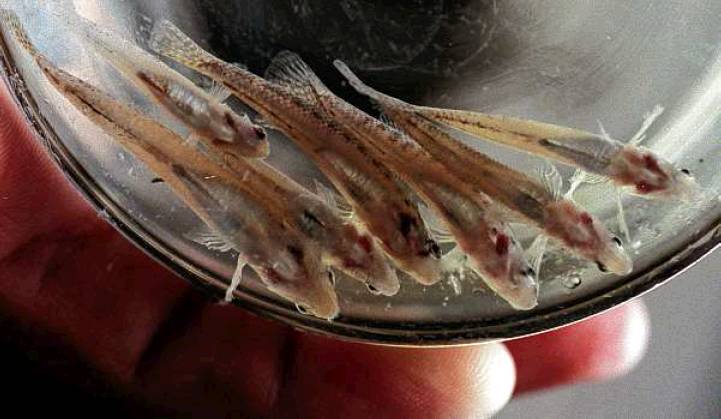AROUND THE REGION
San Marcos River home to 7 endangered species
Humans must act quickly to protect habitats, remove pollution and preserve what’s left of several types of creatures in Texas
By Annie Blanks STAFF WRITER
SAN MARCOS— 2021 wasn’t a good year for the San Marcos gambusia, the tiny fish that called the San Marcos River home but was declared extinct in September by the U.S. Fish and Wildlife Service.
But a handful of endangered species still hanging around are at risk of going the way of the gambusia unless humans act quickly to protect habitats and keep them alive and thriving.
Seven different plant and animal species are listed threatened or endangered in the San Marcos region of the Edwards Aquifer, Spring Lake and the upper four miles of the river, according to U.S. Fish and Wildlife Service and the Texas Parks and Wildlife Department.
The animals are endangered because their numbers are declining and their habitats are increasingly disappearing. The gambusia, for instance, went extinct because of human activities that polluted and weakened the groundwater, which ultimately weakened the habitat.
“The upper San Marcos River is one of the most biologically diverse aquatic ecosystems known in the southwestern United States and has a number of endemic species that are isolated to the upper 4.5 miles of the river,” according to the Meadows Center for Water and the Environment at Texas State University in San Marcos.
Human activities are cited as the factors in all these endangered listings. As Central Texas’ population booms, more houses and commercial businesses are pumping water from the Edwards Aquifer, which means less water for the fish, beetles, amphibians and plants that call the San Marcos home.
The seven endangered species in the San Marcos River are:
Comal Springs dryopid beetle: Averages just 3 millimeters long, according to the Edwards Aquifer Alliance. Its eyes don’t work, and its skin is translucent. The beetle’s habitat is dependent upon a steady flow of water from the springs that feed the river, and as development soars in Central Texas, over-extraction from the aquifer is the beetle’s No. 1 threat.
Peck’s cave amphipod: The Peck’s cave amphipod is slightly larger than its dryopid beetle brethren — it can grow to about half an inch, has five pairs of legs and two sets of antennae. It lives mainly at the bottom of the river among the dead leaves and heavy rocks. It eats anything dry that it can find.
The main habitat threats to the Peck’s cave amphipod are pollution, drought and over-extraction of the spring-fed aquifer.
Fountain darter: The fountain darter fish is even smaller than the now-extinct gambusia, growing to be just about a centimeter long. It thrives in clean, quiet spring waters, which means pollution is its primary threat.
Even though the darter is a fish, it doesn’t have a swim bladder that would allow it to float, so it scoots along the bottom of the river, riding the currents and the flow of the water.
San Marcos salamander: This salamander is the master of disguise — its slimy, reddish-brown amphibian skin perfectly matches the moss and algae at the bottom of Spring Lake that it calls home. They prefer clean, spring-fed water, which is why river pollution is such a large habitat threat.
Comal Springs riffle beetle: The riffle beetle lives in the water but can’t swim, and has wings but can’t fly. It also doesn’t have gills.To breathe, it traps a pocket of air under its belly, almost like a diver’s oxygen tank, and sucks air out from it when it needs to breathe.
The beetle has a lifespan of about two years, and likes to live within about three feet of a spring opening, because it likes its water to be as cold as possible.
Texas blind salamander: True to its name, it has no eyes, can’t see and lives in caves deep underneath the Edwards Aquifer. Instead of eyes, it has two small black dots right underneath the surface of its translucent white skin. Since they live in caves, the salamanders don’t have a lot of predatory competition, and feast primarily on microscopic snails and shrimp.
According to the National Wildlife Federation, the salamanders are almost never seen on the surface of the water. The only way they make it that far is if their water source pushes them up to the top. Other than that, they live, breathe and die in their caves.
Texas wild rice: It’s not rice, but Texas wild rice is a type of underwater grass that is just as beautiful to look at as it is critical to maintain aquatic populations in the San Marcos River.
The grass can grow to be up to 10 feet tall and exists solely within about a mile and a half range of the river. It’s a breeding, hiding and feeding ground for dozens of fish, beetles and other water species, both endangered and not. The velvety, bright green grass can be seen under the clear surface of the water and also acts as a natural filter that helps clear pollution in the river. annie.blanks@express-news.net.
